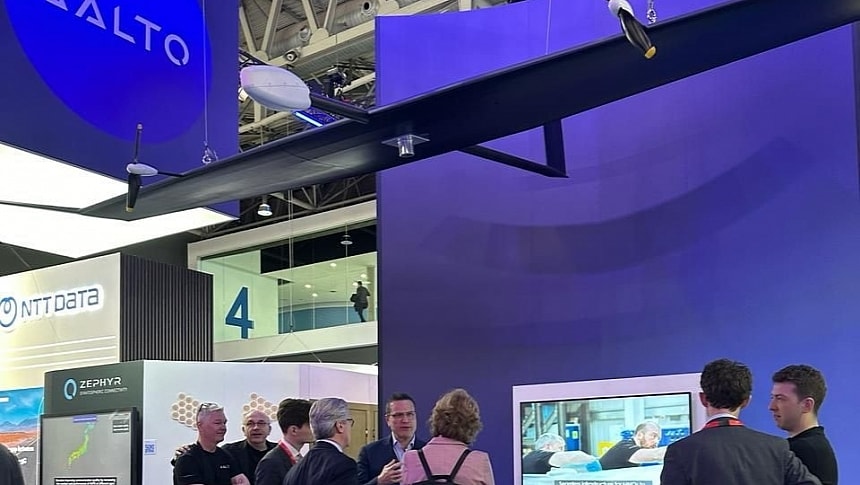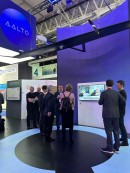This year's Mobile World Congress, considered by many the most influential connectivity event, brought the futuristic Zephyr aircraft back to the public's attention. This innovative contraption, officially a "high-altitude platform station" (HAPS), is about to change connectivity for the better by harnessing solar power combined with cutting-edge technology.
According to AALTO, this HAPS aircraft can provide the same mobile phone coverage as 250 ground-based towers and also do it better and more affordably than low-Earth orbit satellites – and we're talking about a single unit. Imagine what future fleets of these futuristic-looking aircraft could do around the world.
The famous Zephyr has now reached the eighth generation. It's been more than 20 years since the pilot and aerodynamics expert Chris Kelleher first came up with the Zephyr concept – a drone that can operate as a satellite, providing communications to some of the most unconnected areas in the world with zero fuel or harmful emissions.
By 2010, the Zephyr 7 broke the official endurance world record for an unfueled aircraft, reaching a total of 14 days, 22 minutes, and eight seconds – it happened in the US during its maiden flight.
In 2013, it became part of Airbus, and a decade later, Airbus set up AHCSL as a dedicated business entity for stratospheric commercial connectivity services. Airbus HAPS Connectivity Solutions was rebranded as AALTO HAPS and currently operates as an Airbus subsidiary.
Several records later, the innovative Zephyr is closer than ever to hit the market. By next year, AALTO expects to start delivering the first aircraft units to customers after getting the green light from the UK Civil Aviation Authority (CAA). At the same time, the company is gearing up for large-scale manufacturing at its facility near the Farnborough Airport. Somewhere in the near future, it expects to roll out one aircraft per week.
The Zephyr aircraft has been described by Airbus as "a tower in the sky." It combines a surprisingly low take-off weight (under 165 lbs/75 kg) with a huge wingspan of 82 feet/25 meters. It can reach as high as 75,000 feet (22.8 km) in the stratosphere and ensure exceptional endurance.
The goal is to eventually be able to sustain non-stop flight for almost an entire year, but this still depends on the advancement of battery technology. The Zephyr HAPS relies on two motors, a battery pack, and solar arrays mounted on its wings.
This year and the following one could turn out to be some of the most important ones ever for the successful commercialization of Zephyr. Right now, the aircraft is on display at Mobile World Congress 2024 in Barcelona, where it will remain until the end of February – a great opportunity to put the spotlight on this sustainable and highly efficient solution for taking connectivity to the next level.
The famous Zephyr has now reached the eighth generation. It's been more than 20 years since the pilot and aerodynamics expert Chris Kelleher first came up with the Zephyr concept – a drone that can operate as a satellite, providing communications to some of the most unconnected areas in the world with zero fuel or harmful emissions.
By 2010, the Zephyr 7 broke the official endurance world record for an unfueled aircraft, reaching a total of 14 days, 22 minutes, and eight seconds – it happened in the US during its maiden flight.
In 2013, it became part of Airbus, and a decade later, Airbus set up AHCSL as a dedicated business entity for stratospheric commercial connectivity services. Airbus HAPS Connectivity Solutions was rebranded as AALTO HAPS and currently operates as an Airbus subsidiary.
Several records later, the innovative Zephyr is closer than ever to hit the market. By next year, AALTO expects to start delivering the first aircraft units to customers after getting the green light from the UK Civil Aviation Authority (CAA). At the same time, the company is gearing up for large-scale manufacturing at its facility near the Farnborough Airport. Somewhere in the near future, it expects to roll out one aircraft per week.
The Zephyr aircraft has been described by Airbus as "a tower in the sky." It combines a surprisingly low take-off weight (under 165 lbs/75 kg) with a huge wingspan of 82 feet/25 meters. It can reach as high as 75,000 feet (22.8 km) in the stratosphere and ensure exceptional endurance.
The goal is to eventually be able to sustain non-stop flight for almost an entire year, but this still depends on the advancement of battery technology. The Zephyr HAPS relies on two motors, a battery pack, and solar arrays mounted on its wings.
This year and the following one could turn out to be some of the most important ones ever for the successful commercialization of Zephyr. Right now, the aircraft is on display at Mobile World Congress 2024 in Barcelona, where it will remain until the end of February – a great opportunity to put the spotlight on this sustainable and highly efficient solution for taking connectivity to the next level.








